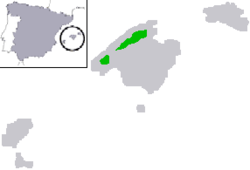| Majorcan midwife toad | |
|---|---|
 | |
| Scientific classification | |
| Kingdom: | Animalia |
| Phylum: | Chordata |
| Class: | Amphibia |
| Order: | Anura |
| Family: | Alytidae |
| Genus: | Alytes |
| Species: | A. muletensis |
| Binomial name | |
| Alytes muletensis (Sanchiz & Adrover, 1977) | |
 | |
The Majorcan midwife toad (Alytes muletensis) (also Mallorcan midwife toad or ferreret in Balearic Catalan and Spanish) is a frog in the family Alytidae (formerly Discoglossidae). It is endemic to the Balearic Island of Majorca in the Mediterranean Sea. An example of Lazarus taxon, the species was first described from fossil remains in 1977, but living animals were discovered in 1979.
Contents
- Characteristics
- Distribution
- Status
- Threats
- Invasive species and predation
- Human activities and habitat alteration
- Disease introduction and lack of habitat maintenance
- References
- External links
The species, considered "endangered" by the International Union for Conservation of Nature (IUCN), is currently restricted to isolated mountain streams in the island's Serra de Tramuntana and has an estimated population of 500 to 1500 breeding pairs in the wild. [1] It does exist and reproduce easily in captivity, however.[ citation needed ] The Majorcan midwife toad is thought to have disappeared from most of the island as a result of the introduction of competitors and predators from the mainland in ancient times.[ who? ] Reintroduction of the species in additional areas has taken place since 1988, with many new breeding populations now well established.[ citation needed ]
